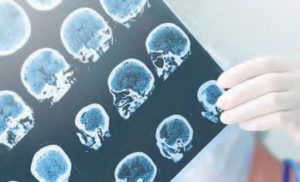 Alzheimer’s disease is a progressive, degenerative disorder that attacks the brain’s nerve cells, or neurons, resulting in loss of memory, thinking and language skills, and behavioral changes. These neurons, which produce the brain chemical, or neurotransmitter, acetylcholine, break connections with other nerve cells and ultimately die. For example, short-term memory fails when Alzheimer’s disease first destroys nerve cells in the hippocampus, and language skills and judgment decline when neurons die in the cerebral cortex. Alzheimer’s disease is the most common cause of dementia, or loss of intellectual function, among people aged 65 and older. Although every case of Alzheimer’s disease is different, experts have identified common warning signs of the brain disease. Alzheimer’s disease is not a normal part of aging, and it is important to look for signs that might indicate Alzheimer’s disease versus basic forgetfulness. With Alzheimer’s disease, these systems gradually increase and become more persistent. If someone is exhibiting these symptoms, the person should check out his or her concerns with a healthcare professional. Awareness of these warning is not a substitute for a structured screening or consultation with a primary care provider.
Alzheimer’s disease is a progressive, degenerative disorder that attacks the brain’s nerve cells, or neurons, resulting in loss of memory, thinking and language skills, and behavioral changes. These neurons, which produce the brain chemical, or neurotransmitter, acetylcholine, break connections with other nerve cells and ultimately die. For example, short-term memory fails when Alzheimer’s disease first destroys nerve cells in the hippocampus, and language skills and judgment decline when neurons die in the cerebral cortex. Alzheimer’s disease is the most common cause of dementia, or loss of intellectual function, among people aged 65 and older. Although every case of Alzheimer’s disease is different, experts have identified common warning signs of the brain disease. Alzheimer’s disease is not a normal part of aging, and it is important to look for signs that might indicate Alzheimer’s disease versus basic forgetfulness. With Alzheimer’s disease, these systems gradually increase and become more persistent. If someone is exhibiting these symptoms, the person should check out his or her concerns with a healthcare professional. Awareness of these warning is not a substitute for a structured screening or consultation with a primary care provider.
 Typical warning signs include: Memory loss, especially of recent events, names, placement of objects, new information, confusion about time and place, and struggling to complete familiar actions, such as brushing teeth or getting dressed. Also trouble finding the appropriate words, completing sentences, and following directions and conversations are signs. There are changes in mood and personality, such as increased suspicion, rapid and persistent mood swings, withdrawal, and disinterest in usual activities.
Typical warning signs include: Memory loss, especially of recent events, names, placement of objects, new information, confusion about time and place, and struggling to complete familiar actions, such as brushing teeth or getting dressed. Also trouble finding the appropriate words, completing sentences, and following directions and conversations are signs. There are changes in mood and personality, such as increased suspicion, rapid and persistent mood swings, withdrawal, and disinterest in usual activities.
 Clinicians can now diagnose Alzheimer’s disease with up to 90 percent accuracy. But it can only be confirmed by an autopsy, during which pathologists look for the disease’s characteristic plaques and tangles in brain tissue. Clinicians can diagnose “probable” Alzheimer’s disease by taking a complete medical history and conducting lab tests, a physical exam, brain scans and neuropsychological tests that gauge memory, attention, language skills and problem-solving abilities. Proper diagnosis is critical since there are dozens of other causes of memory problems. Some memory problems can be readily treated, such as those caused by vitamin deficiencies or thyroid problems. Other memory problems might result from causes that are not currently reversible, such as Alzheimer’s disease. The sooner an accurate diagnosis of “probable” Alzheimer’s disease is made, the easier it is to manage symptoms and plan for the future.
Clinicians can now diagnose Alzheimer’s disease with up to 90 percent accuracy. But it can only be confirmed by an autopsy, during which pathologists look for the disease’s characteristic plaques and tangles in brain tissue. Clinicians can diagnose “probable” Alzheimer’s disease by taking a complete medical history and conducting lab tests, a physical exam, brain scans and neuropsychological tests that gauge memory, attention, language skills and problem-solving abilities. Proper diagnosis is critical since there are dozens of other causes of memory problems. Some memory problems can be readily treated, such as those caused by vitamin deficiencies or thyroid problems. Other memory problems might result from causes that are not currently reversible, such as Alzheimer’s disease. The sooner an accurate diagnosis of “probable” Alzheimer’s disease is made, the easier it is to manage symptoms and plan for the future.
 Alzheimer’s disease typically progresses over two to 20 years, and individuals live on average for eight to 10 years from diagnosis. Individuals with Alzheimer’s disease are likely to develop co-existing illnesses and most commonly die from pneumonia. Alzheimer’s disease is among the top 10 leading causes of death in the U.S. It is estimated that as many as 5.1 million Americans may have Alzheimer’s disease. The numbers of people age 65 and older will more than double between 2010 and 2050 to 88.5 million or 20 % of the population; likewise, those 85 and older will rise three-fold, to 19 million, according to the U.S. Census Bureau.
Alzheimer’s disease typically progresses over two to 20 years, and individuals live on average for eight to 10 years from diagnosis. Individuals with Alzheimer’s disease are likely to develop co-existing illnesses and most commonly die from pneumonia. Alzheimer’s disease is among the top 10 leading causes of death in the U.S. It is estimated that as many as 5.1 million Americans may have Alzheimer’s disease. The numbers of people age 65 and older will more than double between 2010 and 2050 to 88.5 million or 20 % of the population; likewise, those 85 and older will rise three-fold, to 19 million, according to the U.S. Census Bureau.
If you are experiencing forgetfulness with daily routines, please reach out to use in therapy. We have a dedicated team of Speech Therapists who specialize in this and may be able to help. Please join us Wednesday, June 18th at 1:30 pm in the PAC for our Smart Moves presentation on this subject.





 © 2025 Kirby Pines LifeCare Community. All Rights Reserved |
© 2025 Kirby Pines LifeCare Community. All Rights Reserved | 